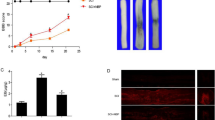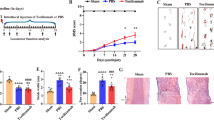Abstract
Vagus nerve stimulation (VNS) is a promising neuromodulation technique, which has been demonstrated to promote functional recovery after spinal cord injury (SCI) in our previous study. But the underlying mechanism remains to be explored. Using a compressed SCI model, our present study first demonstrated that activated microglia produce abundant tumor necrosis factor-α (TNF-α) to induce endothelial necroptosis via receptor-interacting protein kinase 1 (RIP1)/RIP3/mixed lineage kinase domain-like protein (MLKL) pathway, thus destroying the blood-spinal cord barrier (BSCB) after SCI. While both TNF-α specifical antibody (infliximab) and necroptosis inhibitor (necrostatin-1) alleviate BSCB disruption. Then our study found that VNS significantly inhibits microglia-derived TNF-α production and reduces expression of p-RIP3 and p-MLKL in endothelial cells. As expected, further results indicated that VNS mitigates the BSCB disruption, thus reducing inflammatory cells infiltration and neural damage. Finally, both electrophysiological evaluation and locomotor test demonstrated that VNS promotes motor function recovery after SCI. In conclusion, our data demonstrated VNS restricts microglia-derived TNF-α to prevent RIP1/RIP3/MLKL mediated endothelial necroptosis, thus alleviating the decisive pathophysiological BSCB disruption to reduce neuroinflammation and neural damage, which ultimately promotes motor function recovery after SCI. Therefore, these results further elaborate that VNS might be a promising therapeutic strategy for SCI.
Graphical Abstract
Vagus nerve stimulation prevents microglia-derived TNF-α induced endothelial necroptosis to alleviate blood-spinal cord barrier disruption after spinal cord injury.







Similar content being viewed by others
Data Availability
All data that support the fndings of this study are available from the corresponding author upon reasonable request.
References
Global, regional, and national burden of traumatic brain injury and spinal cord injury, 1990–2016: a systematic analysis for the Global Burden of Disease Study 2016 (2019). Lancet Neurol 18(1):56–87. https://doi.org/10.1016/s1474-4422(18)30415-0
Courtine G, Sofroniew MV (2019) Spinal cord repair: advances in biology and technology. Nat Med 25(6):898–908. https://doi.org/10.1038/s41591-019-0475-6
Dawson J, Liu CY, Francisco GE, Cramer SC, Wolf SL, Dixit A, Alexander J, Ali R et al (2021) Vagus nerve stimulation paired with rehabilitation for upper limb motor function after ischaemic stroke (VNS-REHAB): a randomised, blinded, pivotal, device trial. Lancet (London, England) 397(10284):1545–1553. https://doi.org/10.1016/s0140-6736(21)00475-x
Bowles S, Hickman J, Peng X, Williamson WR, Huang R, Washington K, Donegan D, Welle CG (2022) Vagus nerve stimulation drives selective circuit modulation through cholinergic reinforcement. Neuron 110(17):2867-2885.e2867. https://doi.org/10.1016/j.neuron.2022.06.017
Chen H, Feng Z, Min L, Deng W, Tan M, Hong J, Gong Q, Zhang D et al (2022) Vagus Nerve Stimulation Reduces Neuroinflammation Through Microglia Polarization Regulation to Improve Functional Recovery After Spinal Cord Injury. Front Neurosci 16:813472. https://doi.org/10.3389/fnins.2022.813472
Degterev A, Huang Z, Boyce M, Li Y, Jagtap P, Mizushima N, Cuny GD, Mitchison TJ et al (2005) Chemical inhibitor of nonapoptotic cell death with therapeutic potential for ischemic brain injury. Nat Chem Biol 1(2):112–119. https://doi.org/10.1038/nchembio711
Yuan J, Amin P, Ofengeim D (2019) Necroptosis and RIPK1-mediated neuroinflammation in CNS diseases. Nat Rev Neurosci 20(1):19–33. https://doi.org/10.1038/s41583-018-0093-1
Lee CS, Hwang G, Nam YW, Hwang CH, Song J (2023) IKK-mediated TRAF6 and RIPK1 interaction stifles cell death complex assembly leading to the suppression of TNF-α-induced cell death. Cell Death Differ. https://doi.org/10.1038/s41418-023-01161-w
Chen AQ, Fang Z, Chen XL, Yang S, Zhou YF, Mao L, Xia YP, Jin HJ et al (2019) Microglia-derived TNF-α mediates endothelial necroptosis aggravating blood brain-barrier disruption after ischemic stroke. Cell Death Dis 10(7):487. https://doi.org/10.1038/s41419-019-1716-9
Huang WY, Lai YL, Liu KH, Lin S, Chen HY, Liang CH, Wu HM, Hsu KS (2022) TNFα-mediated necroptosis in brain endothelial cells as a potential mechanism of increased seizure susceptibility in mice following systemic inflammation. J Neuroinflammation 19(1):29. https://doi.org/10.1186/s12974-022-02406-0
Sweeney MD, Zhao Z, Montagne A, Nelson AR, Zlokovic BV (2019) Blood-Brain Barrier: From Physiology to Disease and Back. Physiol Rev 99(1):21–78. https://doi.org/10.1152/physrev.00050.2017
Jin LY, Li J, Wang KF, Xia WW, Zhu ZQ, Wang CR, Li XF, Liu HY (2021) Blood-Spinal Cord Barrier in Spinal Cord Injury: A Review. J Neurotrauma 38(9):1203–1224. https://doi.org/10.1089/neu.2020.7413
Zhang S, Zhao J, Wu M, Zhou Y, Wu X, Du A, Tao Y, Huang S et al (2023) Over-activation of TRPM2 ion channel accelerates blood-spinal cord barrier destruction in diabetes combined with spinal cord injury rat. Int J Biol Sci 19(8):2475–2494. https://doi.org/10.7150/ijbs.80672
Kumar H, Ropper AE, Lee SH, Han I (2017) Propitious Therapeutic Modulators to Prevent Blood-Spinal Cord Barrier Disruption in Spinal Cord Injury. Mol Neurobiol 54(5):3578–3590. https://doi.org/10.1007/s12035-016-9910-6
Feng Z, Min L, Liang L, Chen B, Chen H, Zhou Y, Deng W, Liu H et al (2021) Neutrophil Extracellular Traps Exacerbate Secondary Injury via Promoting Neuroinflammation and Blood-Spinal Cord Barrier Disruption in Spinal Cord Injury. Front Immunol 12:6982409. https://doi.org/10.3389/fimmu.2021.698249
Kumar H, Lim CS, Choi H, Joshi HP, Kim KT, Kim YH, Park CK, Kim HM et al (2020) Elevated TRPV4 Levels Contribute to Endothelial Damage and Scarring in Experimental Spinal Cord Injury. J Neurosci: Off J Soc Neurosci 40(9):1943–1955. https://doi.org/10.1523/jneurosci.2035-19.2020
Xie C, Wang Y, Wang J, Xu Y, Liu H, Guo J, Zhu L (2023) Perlecan Improves Blood Spinal Cord Barrier Repair Through the Integrin β1/ROCK/MLC Pathway After Spinal Cord Injury. Mol Neurobiol 60(1):51–67. https://doi.org/10.1007/s12035-022-03041-9
Weaver LC, Verghese P, Bruce JC, Fehlings MG, Krenz NR, Marsh DR (2001) Autonomic dysreflexia and primary afferent sprouting after clip-compression injury of the rat spinal cord. J Neurotrauma 18(10):1107–1119. https://doi.org/10.1089/08977150152693782
Chengke L, Weiwei L, Xiyang W, Ping W, Xiaoyang P, Zhengquan X, Hao Z, Penghui Z et al (2013) Effect of infliximab combined with methylprednisolone on expressions of NF-κB, TRADD, and FADD in rat acute spinal cord injury. Spine 38(14):E861-869. https://doi.org/10.1097/BRS.0b013e318294892c
Wang S, Wu J, Zeng YZ, Wu SS, Deng GR, Chen ZD, Lin B (2017) Necrostatin-1 Mitigates Endoplasmic Reticulum Stress After Spinal Cord Injury. Neurochem Res 42(12):3548–3558. https://doi.org/10.1007/s11064-017-2402-x
Feng Z, Min L, Chen H, Deng W, Tan M, Liu H, Hou J (2021) Iron overload in the motor cortex induces neuronal ferroptosis following spinal cord injury. Redox Biol 43:101984. https://doi.org/10.1016/j.redox.2021.101984
Basso DM, Beattie MS, Bresnahan JC (1995) A sensitive and reliable locomotor rating scale for open field testing in rats. J Neurotrauma 12(1):1–21. https://doi.org/10.1089/neu.1995.12.1
Bartanusz V, Jezova D, Alajajian B, Digicaylioglu M (2011) The blood-spinal cord barrier: morphology and clinical implications. Ann Neurol 70(2):194–206. https://doi.org/10.1002/ana.22421
Zhou Y, Wen LL, Li YF, Wu KM, Duan RR, Yao YB, Jing LJ, Gong Z et al (2022) Exosomes derived from bone marrow mesenchymal stem cells protect the injured spinal cord by inhibiting pericyte pyroptosis. Neural Regen Res 17(1):194–202. https://doi.org/10.4103/1673-5374.314323
Benton RL, Maddie MA, Worth CA, Mahoney ET, Hagg T, Whittemore SR (2008) Transcriptomic screening of microvascular endothelial cells implicates novel molecular regulators of vascular dysfunction after spinal cord injury. J Cerebral Blood Flow Metab: Off J Int Soc Cerebral Blood Flow Metab 28(11):1771–1785. https://doi.org/10.1038/jcbfm.2008.76
Wang Y, Zhan G, Cai Z, Jiao B, Zhao Y, Li S, Luo A (2021) Vagus nerve stimulation in brain diseases: Therapeutic applications and biological mechanisms. Neurosci Biobehav Rev 127:37–53. https://doi.org/10.1016/j.neubiorev.2021.04.018
Funding
This work was supported by grants 82172542 (H.L.L.) and U19A2082 (J.M.H.) from the National Natural Science Foundation of China, CQYC20210510203 (J.M.H.) from the Chongqing Talents Project, and cst2021jcyj-msxmX0612 (J.M.H.) from the Natural Science Foundation of Chongqing.
Author information
Authors and Affiliations
Contributions
Study conception and design: JMH; animal model establishment: LXM, MLT; experiment implementation: HC, ZF, DYZ; manuscript draft: HC, ZF, QWG; critical revision: JMH, HLL. All authors approved the submitted version.
Corresponding author
Ethics declarations
Ethics approval
This study was performed in line with the principles of the Declaration of Helsinki. Approval was granted by the Ethics Committee of Third Military Medical University (Army Medical University) for the use of laboratory animals (approval no. AMUWEC20210377).
Informed Consent
Not applicable.
Consent to Participate
Not applicable.
Consent for Publication
Not applicable.
Conflict of Interest
The authors declare that they have no conflicts of interest.
Additional information
Publisher's Note
Springer Nature remains neutral with regard to jurisdictional claims in published maps and institutional affiliations.
Hui Chen and Zhou Feng have contributed equally to this work and share first authorship.
Rights and permissions
Springer Nature or its licensor (e.g. a society or other partner) holds exclusive rights to this article under a publishing agreement with the author(s) or other rightsholder(s); author self-archiving of the accepted manuscript version of this article is solely governed by the terms of such publishing agreement and applicable law.
About this article
Cite this article
Chen, H., Feng, Z., Min, L. et al. Vagus Nerve Stimulation Prevents Endothelial Necroptosis to Alleviate Blood-Spinal Cord Barrier Disruption After Spinal Cord Injury. Mol Neurobiol 60, 6466–6475 (2023). https://doi.org/10.1007/s12035-023-03477-7
Received:
Accepted:
Published:
Issue Date:
DOI: https://doi.org/10.1007/s12035-023-03477-7




